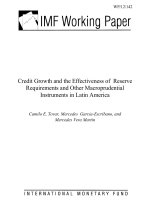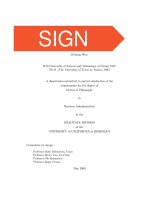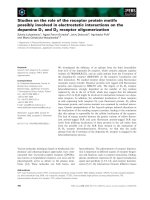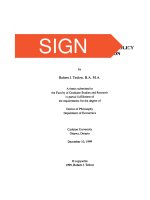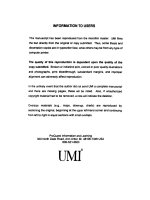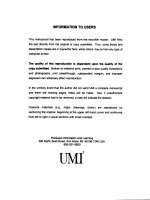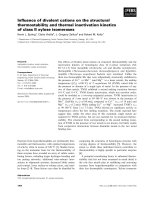Three essays on the credit growth and banking structure of Central and Eastern European countries
Bạn đang xem bản rút gọn của tài liệu. Xem và tải ngay bản đầy đủ của tài liệu tại đây (1.3 MB, 142 trang )
THREE ESSAYS ON THE CREDIT GROWTH AND BANKING STRUCTURE
OF CENTRAL AND EASTERN EUROPEAN COUNTRIES
by
Burcu Aydin
A Dissertation Presented to the
FACULTY OF THE GRADUATE SCHOOL
UNIVERSTIY OF SOUTHERN CALIFORNIA
In Partial Fulfillment of the
Requirements for the Degree
DOCTOR OF PHILOSOPHY
(ECONOMICS)
August 2007
Copyright 2007 Burcu Aydin
UMI Number: 3278377
3278377
2007
UMI Microform
Copyright
All rights reserved. This microform edition is protected against
unauthorized copying under Title 17, United States Code.
ProQuest Information and Learning Company
300 North Zeeb Road
P.O. Box 1346
Ann Arbor, MI 48106-1346
by ProQuest Information and Learning Company.
i
Dedication
To
My parents Nesibe and Husamettin
And my brother Mirkan
ii
Acknowledgments
I would like to thank my advisors; Robert Dekle, John Ham, and Cheng
Hsiao for making valuable comments and suggestions. They regularly provided me
with encouragement and guidance for my research.
Also, I would like to thank Selahattin Imrohoroglu for accepting the role of
outside member of my dissertation committee, and for providing his valuable
comments throughout the writing of this dissertation.
I am greatly indebted to Wim Fonteyne from the International Monetary
Fund. It would not have been possible to write my thesis without his support,
guidance, and precious comments.
I would like to thank the participants in the seminars held at the International
Monetary Fund, Europe Department in July 2006, and the University of Southern
California in September 2006.
Last, I am grateful to my family for always supporting me. It would not have
been possible to complete this work, or any of my achievements, without feeling
their love and their faith in me.
iii
Table of Contents
Dedication i
Acknowledgments ii
List of
Tables v
List of Figures vii
Abbreviations viii
Abstract x
Chapter 1: Introduction 1
Chapter 2: Literature Review 12
Chapter 3: The Impact of Foreign Bank Ownership on Credit Growth in Central
and Eastern European Countries 15
3.1 Stylized facts about Eastern European Countries 19
3.2 Data 23
3.3 Empirical Model 31
3.3.1 Concerns about Endogeneity of the Foreign Ownership Variable 36
3.3.1 Concerns about Multicollinearity 40
3.4 Results 42
3.4.1 Impact of Microeconomic Shocks 48
3.4.2 Impact of Macroeconomic Shocks 54
3.6 Conclusion 57
Chapter 4: The Managerial Impact of Parent Banks on their Affiliated Banks
Operating in Foreign Countries: A Case Study for the Central and Eastern
European Countries 59
4.1 Data 65
4.2 Empirical Model 73
4.2.1 Concerns about Multicollinearity 77
4.2.2 Do Parent Banks have different Managerial Strategies? 79
4.3 Results 83
iv
4.4.1 Impact of Microeconomic Shocks 93
4.4.2 Impact of Macroeconomic Shocks 97
4.4 Conclusion 100
Chapter 5: The Lessons from the EMU Countries 101
5.1 Are there any similarities between the CEE and the EMU-5 Countries? 105
5.2 Data 108
5.3 Econometric Model 113
5.3.1 Concerns about Multicollinearity 115
5.4 Results from the EMU-5 Banking Structure 117
5.4.1 Impact of Microeconomic Shocks 121
5.4.2 Impact of Macroeconomic Shocks 122
5.5 Conclusion 123
Bibliography 125
v
List of Tables
Table 1: Market Share of Foreign-Owned Banks in CEE Countries 20
Table 2: Summary Statistics for the CEE Countries 27
Table 3: Pairwise Correlation Coefficients between Credit Growth and its
Lagged Value for the CEE Banks 32
Table 4: Panel Data Probit Estimation Results for Foreign Ownership Variable 37
Table 5: Hausman Specification Test for Foreign Ownership Dummy 39
Table 6: Correlation Coefficient across Regressors for the CEE Countries 41
Table 7: Fixed Effect Estimator Results for the CEE Countries 43
Table 8: Fixed Effect Estimator Results for the CEE Countries 44
Table 9: Fixed Effect Estimator Results for the CEE Countries 45
Table 10: Cross-Ownership Varying FE Estimators for the CEE Countries 46
Table 11 : Cross-Ownership Varying FE Estimators for the CEE Countries 47
Table 12: List of Parent Banks and their Affiliated Companies 67
Table 13: Summary Statistics for Parent Banks and their CEE Subsidiaries 70
Table 14: Pairwise Correlation Coefficient between Credit Growth and its
Lagged Value for Each CEE Subsidiary 74
Table 15: Correlation Coefficients across Variables of Interest 78
Table 16: FE regression results for cross-sectional varying coefficients 81
Table 17: Test of Different Coefficient Estimates across Affiliated Banks 82
vi
Table 18: FE Estimator for Credit Growth in the CEE Subsidiaries 85
Table 19: FE Estimator for Credit Growth in the CEE Subsidiaries 86
Table 20: FE Estimator for Credit Growth in the CEE Subsidiaries 87
Table 21: FE Estimator for Credit Growth in the CEE Subsidiaries 88
Table 22: FE Estimator for Credit Growth in the CEE Subsidiaries 89
Table 23: FE Estimator for Credit Growth in the CEE Subsidiaries 90
Table 24: FE Estimator for Credit Growth in the CEE Subsidiaries 91
Table 25: FE Estimator for Credit Growth in the CEE Subsidiaries 92
Table 26: Summary Statistics for EMU-5 109
Table 27: Pairwise Correlation Coefficient between Credit Growth 114
Table 28: Correlation Coefficient across Regressors for the EMU-5 Countries 116
Table 29: Fixed Effect Estimator Results for EMU-5 119
Table 30: Fixed Effect Estimator Results for EMU-5 120
vii
List of Figures
Figure 1: Credit as a Percentage of GDP 22
Figure 2: Number of Banks per Ownership Category 26
Figure 3: Credit Growth across Bank Ownership Types in CEE Countries 49
Figure 4: Comparison of the transition indicators between the CEE and EMU-5
Countries 107
Figure 5: Mean and Standard Deviation of Banking Variables across Years in
EMU Countries 110
viii
Abbreviations
AIC Akaike Information Criteria
AR(2) Second-order Autoregressive Process
BIC Bayesian Information Criteria
CEE Central and Eastern Europe
ECB European Central Bank
EMU Economic and Monetary Union
EMU-5 Greece, Ireland, Italy, Portugal and Spain
EU European Union
FE Fixed Effects
GAAP Generally Accepted Accounting Principles
GDP Gross Domestic Product
IFRS International Financial Reporting Standards
IV Instrumental Variable
M3 A Measure of Money Supply
MIGA Multilateral Investment Guarantee Agency
n.a. Data not available
NIM Net Interest Margin
OLS Ordinary Least Squares
r Real Interest Rate
ix
ROA Return on Average Assets
ROE Return on Average Equity
TA Total Assets
TCR Total Capital Ratio
TSLS Two-Stage Least-Squares Estimator
US United States of America
x
Abstract
This thesis is comprised of three essays on the credit growth and banking
structure of the Central and Eastern European Countries (CEE). The first essay
studies the importance of bank ownership on this growth, the second explores the
influence of the managerial impact on credit growth and the third one draws
projections for the future EMU membership of the CEE countries from the past
experiences of the five current EMU states.
The first essay studies the impact of foreign bank ownership on credit growth
for the CEE countries. The analysis is based on an unbalanced panel for the 72
largest banks from these countries. The results indicate foreign bank ownership is
significant in raising credit. Although foreign banks have higher credit growth
compared to domestic banks, further analysis shows that private domestic banks in
fact also have high credit growth. Except for their means of raising funds, foreign
and private domestic banks share similar characteristics in terms of bank
performance and efficiency, whereas significant differences exist between private
domestic and state-owned banks.
The second essay studies the managerial impact on credit growth for foreign-
owned banks operating in the CEE countries which own around 70 percent of the
total CEE banking assets. The analysis is based on an unbalanced panel of 16 years
and 59 banks, comprised of 18 parent banks and their 41 CEE subsidiaries. This
study indicates that the size of the parent bank, the flow of funds between affiliated
xi
banks, interest margins, and the macroeconomic situation in the host market play
important roles for credit growth in CEE banks owned by foreigners.
The third essay draws projections on the future Economic and Monetary
Union (EMU) membership of the CEE countries based on the experiences of the five
current member states of the EMU (EMU-5) which formerly had similar
macroeconomic dynamics to those of the CEE countries. The analysis is based on an
unbalanced panel for the 44 largest banks operating in the EMU-5 countries. The
results show that the liquidity structure of the EMU-5 banks change as well as the
macroeconomic conditions after the introduction of the Euro.
1
Chapter 1
Introduction
Around 1990 and onwards, Europe experienced major changes both
politically and economically. The most important change in Central and Eastern
European (CEE) countries was the transition from a centrally planned economy to a
market based system. During the same years Western Europe also experienced major
changes: introduction of the single market and then the move towards a common
currency area. The following decade for the CEE countries was marked by their
membership to the European Union (EU) and their next step will be the entrance to
the common currency system.
The 1990s transition in the ten CEE countries: Bulgaria,
Romania, Czech
Republic, Hungary, Poland, Slovakia, Slovenia, Estonia, Latvia, and Lithuania
caused major changes in their economic environment. The CEE countries liberalized
their institutions, went through a major privatization process and opened their
markets toward a free-market economy. As a product of these privatization and
liberalization processes the CEE countries experienced an important change in their
2
financial markets, namely a significant rise in the share of foreign ownership in their
banking structure, followed by high credit growth levels in the domestic economy.
This thesis studies the economic implications of foreign bank ownership and the
credit growth pattern in the CEE countries.
The rapid credit growth in the CEE countries is of interest for two reasons.
First, domestic credit as a share of GDP has been increasing continuously in the CEE
countries from 1990 onwards and this rapid credit growth is a reflection of economic
growth and financial integration toward more developed countries. Second, rapid
credit growth, if identified as a credit boom, can have undesirable effects on an
economy - such as systematic banking crises and economic recessions
1
- and
standard economic theory does not differentiate between rapid credit growth and
credit boom.
The financial markets of the CEE countries are heavily dominated by the
banking sector and their capital markets are not well developed. Therefore the rapid
credit growth in the CEE countries will come through a rise in bank loans. The
banking system in this region experienced notable adjustments throughout the
transition period from centrally planned economies to market economies. During this
transition the CEE countries privatized a significant portion of their state-owned
banks and foreign investors, directly and indirectly, acquired the majority of banking
1
There is a high correlation between credit booms and currency or systematic banking crises
(Terrones and Mendoza (2004)).
3
assets from these sales. Additionally, during this period foreign banks also started to
open subsidiaries and branches in the CEE countries. After accounting for all the
changes in banks’ ownership structure and greenfield investments, foreign investors
became the major share holders in the CEE banking sector.
The first essay in this thesis, The Impact of Foreign Bank Ownership on
Credit Growth in Central and Eastern European Countries, studies the importance
of bank ownership structure for the growth of credit in the CEE countries. The
foreign bank ownership for the credit growth pattern of the CEE countries is of
interest for several reasons. First, foreign banks bring the know-how to the CEE
countries which increases the efficiency of credit distribution. Under the command
economy, banks operating in the CEE countries did not act as financial
intermediaries but rather as record keepers. However, throughout the transition and
after that, banks needed to engage in credit evaluation and risk management
activities. Foreign acquisition of the CEE banks channeled the network of experience
and better technology from financially advanced countries to the CEE banks. For
example, the banking system indicators - such as higher information technology,
better risk management, and credit evaluation - improved in the CEE countries
between the 1990s and the 2000s [ECB (2005A)] during the foreign acquisition of
the CEE banks. The enhanced banking system in the CEE countries provides a more
efficient credit channeling and improved financial intermediation, and hence it
increases the credit growth in the CEE countries.
4
Second, foreign banks are not restricted by domestic market conditions and
this allows the foreign banks to increase the credit line much faster than the domestic
banks. A majority of the foreign banks are owned by very large multinational banks,
and the financial needs of these CEE subsidiaries can be met by funds coming from
the parent bank. Additionally, a foreign bank has more credibility than a private
domestic bank due to the reputation of its parent bank. Therefore a foreign bank can
also raise more credit than the private domestic bank by borrowing from other banks.
The easier access to interbank lending provides more financial resources to foreign
banks, which in turn lets them make more loans.
Third, foreign banks increase the amount of competition in the CEE banking
system which leads to an outward shift in the supply of credit
2
. This shift in the
supply of credit reduces the equilibrium spread between bank lending and borrowing
rate and increases equilibrium borrowing in the country. Greater competition in the
banking system is helpful in improving financial intermediation and efficiency.
Financial intermediation in the CEE countries gets better as both the number of
banks operating in these countries and the financial services that they offer increase
3
.
The efficiency in the CEE countries’ financial markets increases as the shift in the
supply curve decreases the cost of borrowing. The increase in financial
2
The number of banks operating in the CEE countries and the share of foreign owned assets increased
from 1990 and onwards in the CEE countries.
3
M3 as a ratio of GDP is a measure of financial development, and this ratio increased between the
1990s and 2000s in the CEE countries.
5
intermediation and efficiency allows the CEE firms and households to satisfy their
financial needs via bank credit.
This essay explicitly studies the different behavior of foreign bank ownership
with respect to domestic ownership types: private and state ownership in chapter 3.
The analysis in chapter 3 uses a panel dataset covering the years 1988 to 2005 for the
largest 72 banks in the ten CEE countries. The results show that there is a structural
break in the dataset by the 2000s in terms of bank level and macroeconomic
indicators due to the transition of these CEE countries and the banking and currency
crises that happened during the 1990s. Further results show that high interest margins
and economic growth are the two driving forces for foreign banks to enter to the
CEE markets. In terms of credit growth, foreign-owned banks on average have
higher loan growth rates than domestically-owned banks. However, by the 2000s the
estimation results indicate that the average credit growth rate of foreign banks is
higher than the state owned banks, but significantly lower than that of domestically
owned private banks. The long-term customer relations between the private domestic
banks and the CEE companies may be the underlying reason for this result. In terms
of funding the bank loans, foreign owned banks show significant differences from
domestic ownership types. By the 2000s, interbank lending becomes the major
source of funding for foreign owned banks, whereas domestically owned banks still
rely on domestic market conditions. By the 2000s, cost and efficiency indicators lose
importance on the growth of credit for private banks, but still remain important for
6
state owned banks. The insignificance of these indicators for private banks shows the
importance of the ‘know-how’ effect that foreign banks bring to the CEE countries.
The second essay, The Managerial Impact of Parent Banks on their Affiliated
Banks Operating in Foreign Countries: A Case Study for the Central and Eastern
European Countries, analyzes the impact of parent banks on the credit growth
pattern of their CEE subsidiaries. The transition in the CEE banking system and the
change in bank ownership caused the majority of the banks to move from domestic
to foreign ownership by late the 1990s and 2000s
4
. After the change in bank
ownership, the majority of the foreign owned CEE banks were acquired by Western
Europeans who are in close geographical proximity to the CEE subsidiaries. For
example; Austrian, German, and Italian banks acquired the banks in central Europe,
and Scandinavian banks owned the banks operating in Baltic countries. This high
degree of foreign bank ownership in the CEE banking system motivates this
investigation of the impact of the parent banks on the credit growth pattern of the
CEE countries. The interest for the fourth chapter of this thesis is based on the
following factors.
First, the credit growth pattern in the CEE countries may be affected by the
financial situation of the controlling bank or by the domestic market conditions that
the parent bank faces. A majority of these parent banks own several banks operating
4
In the CEE countries, around 70 percent of the total banking assets are controlled by foreigners the
2000s (ECB, eurostat database).
7
in various CEE countries. Therefore a change in the firm level or market level
conditions that these parent banks face may cause a change in the credit growth
pattern of their subsidiaries, which constitute the majority of the banking assets in
the CEE countries. The profitability of the parent bank has an influence on the
magnitude of operations that its branches will engage. A strand of the economic
theory suggests that a financial downturn may force a multinational bank to reduce
its operations company wide. For the macroeconomic conditions that the parent bank
faces at its headquarters or home country, a branch of economic theory suggests that
an economic downturn in the home market will cause the multinational bank to
reduce its operations company wide
5
. According to this strand of theory, the credit
line at the CEE subsidiaries may decline if the financial situation of the parent bank
and/or the macroeconomic conditions in the home country worsens.
On the other hand, the financial diversification theory suggests that the
profitability of the subsidiary or the growth prospects in the CEE countries are more
important for the multinational bank’s decision whether or not to extend the credit
line in the CEE countries. The profitability of the subsidiary will motivate the parent
bank to extend its operations at the subsidiary when the multinational company’s
prospects at home are declining. For the host country’s macroeconomic conditions,
the regional or global diversification policy of these multinational banks suggests
that the multinational banks increase their operations in regions with high economic
5
De Haas and Lelyveld (2003) discuss that the macroeconomic conditions that the parent bank faces
plays and important role in reducing the credit line of the subsidiaries operating abroad.
8
growth potentials. Low growth rates in the home market may stimulate the parent
banks to extend their operations in the CEE countries. In the future, a falling growth
rate in the CEE countries due to economic convergence or low interest margins due
to increased competition may lead the parent bank to limit their operations in the
CEE markets.
Secondly, all of the CEE countries are targeting a join with the EMU in the
near future. Both the macroeconomic indicators and the institutional framework in
these countries are being aligned to meet the EMU standards. Therefore the
European monetary policy, in particular the Euro area, has an important impact on
the credit growth pattern of the CEE countries. Due to the financial integration of the
CEE countries towards the Economic and Monetary Union (EMU) the spread
between domestic and Euro area interest rates lose importance over time and the
economic integration of the CEE countries increases the importance of EMU on the
CEE macroeconomic indicators. The EMU monetary policy affects the credit growth
in the CEE country and this impact is sounder in the 2000s. A monetary expansion in
the CEE countries (an increase in M3) and a decline in interest rates may cause a rise
in the CEE credit growth.
The analysis in this chapter is based on a panel dataset covering the period
1990 to 2005 for 59 banks, comprised of 18 parent banks and their 41 CEE
subsidiaries. The results indicate that the size of the parent bank matters for the
growth of credit: CEE banks can increase their credit line further as the parent bank
gets larger. Highlighting the impact of inter-bank lending, interbank liabilities of the
9
parent bank are significant and negative for the credit growth of foreign owned banks
operating in the CEE countries. This may indicate that parent banks may need to
borrow externally to finance the credit supply of its subsidiaries. The spreads in the
home market also influences the growth pattern of credit. As home market spreads
decline, the parent banks increase their CEE lending. Finally, Euro area monetary
policy has an impact on the CEE credit growth in terms of interest rate policy and
money growth: a monetary expansion in the EMU is followed by a rise in credit
growth in the CEE countries.
The third essay in this thesis is Lessons from the EMU Countries. This essay
is provided in chapter 4, and it draws projections on the EMU membership of the
CEE countries based on the experiences of the five current member states of the
EMU; Greece, Ireland, Italy, Spain, and Portugal (EMU-5). The post transition
period, the 2000s, was marked by the EU membership of the CEE countries. The
next transition for the CEE countries will be their membership to the monetary
union. On the way to their next destination, i.e. the monetary union, the CEE
countries have been experiencing similar macroeconomic conditions as that of the
EMU-5. The CEE countries have been converging from high inflation and interest
rates to the EMU level; they have been running current account deficits,
experiencing capital inflows, rising asset prices and robust domestic demand growth.
These macro conditions are very similar to those experienced by the EMU-5
countries before entering the euro area. Most importantly, the current credit growth
10
pattern in the CEE countries resembles that of the EMU-5 before their entrance to
the common currency area.
After the introduction of the Euro, domestic demand and economic growth
declined sharply in the EMU-5 markets which ended up in a credit crunch for all the
EMU-5 countries except Ireland a few years after joining the monetary union
6
. Even
though the economic growth slowed down in these countries, the credit crunch did
not cause any systematic risks to the banking sector. Considering the possibility that
the CEE countries may experience a similar stagnation in the macroeconomic
environment, this chapter draws projections for the CEE countries from the credit
growth pattern of the EMU-5 countries before and after their transition to the
monetary union. Even though the banking structure in the EMU-5 and CEE markets
have differences, a road map for the CEE countries can potentially be prepared by
drawing lessons from the past experiences of the EMU-5 countries and the transition
in their banking system.
This chapter uses a panel data from the banking and macroeonomic data of
the EMU-5 countries. The dataset covers banking sector indicators from the 44
largest banks operating in EMU-5 countries from 1988 to 2005. The paper studies
the data for two periods: 1988-2000 and 2001 to 2005. The time break in the dataset
is due to the change in economic environment in the EMU-5 countries before and
6
Italy and Portugal were in Euro Trap after the second year of joining the monetary union, and
further, Spain and Greece show the symptoms of getting caught in the same undesirable path. The
symptoms of the Euro trap are the loss of competitiveness, slow economic growth or recession,
increasing budget deficits and worsening capital account deficits (Mayer (2006)).
11
after the introduction of the Euro. The results from this chapter show that the
downturn of the economic boom in the 2000s caused a change in the domestic saving
behavior in the EMU-5 markets i.e.; savings increased and lending decreased. Even
though a majority of the banking indicators are pro cyclical, the change in the
economic environment and the saving behavior did not cause an increase in the
amount of risk EMU-5 banks were facing in the 2000s.
12
Chapter 2
Literature Review
The literature has thus far paid little attention to foreign bank ownership and
credit growth. Many articles focus either on the credit growth side or on the effects
of foreign ownership on banking performance. On the credit growth side, many
papers focus on the possible implications of such growth but not necessarily on the
role of bank ownership in this growth. Lambregts and Ottens (2006) study the causes
of banking crises in emerging market economies by using a multivariate logit model.
This work presents that a developing economy experiencing rapid lending growth
will face potential banking system fragilities. Cottarelli et al (2003) focus in
particular on Central and Eastern Europe in studying the risk structure of rapid credit
growth. In this paper, they estimate an equilibrium level of bank-credit-to-GDP ratio
in order to evaluate whether these developments in Central and Eastern Europe are
part of a convergence and financial deepening process and they present results that
are consistent with this hypothesis. Kraft and Jankov (2005) study the impact of
lending booms for banking and currency crises in Croatia. They argue that rapid loan

